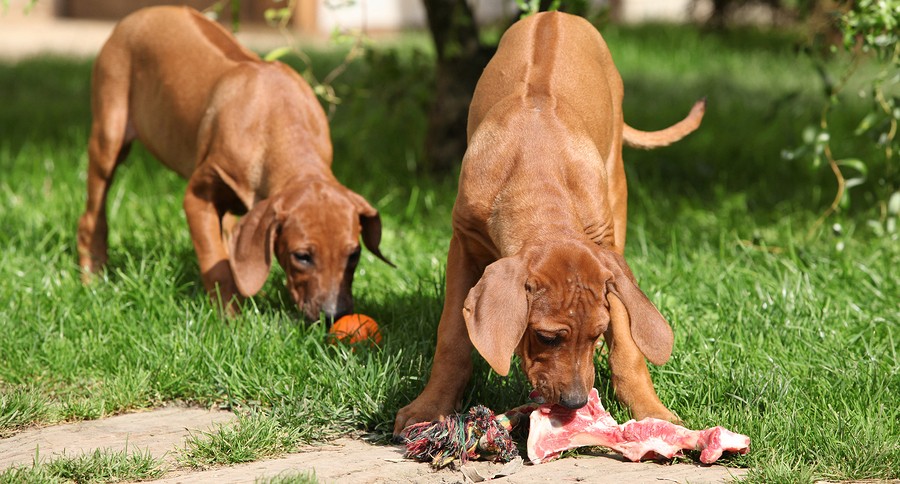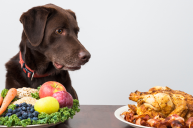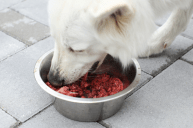Raw food diets are becoming more and more popular with dog owners. There's an increasing awareness of the importance that nutrition can play in your dog's health, so it's only natural to seek out the diet option that works best for your dog. And for many dogs, raw food diets work well.
The basic idea of a raw diet is that dogs should eat the same diet that wolves eat, because that's what their bodies are best adapted for. A raw diet consists of muscle meat still on the bone, organ meats, raw eggs, vegetables, and fruits. But before making the change to feeding raw, it's important to understand the potential issues that can come with these diets so you can make the choice that's best for your dog.
Controversy Over Raw Diets
Raw diets for dogs are controversial. Many dog owners feed their dogs raw diets because they do not think commercial pet food is good for dogs. The argument is that dogs are not meant to eat grains, which is the primary ingredient in commercial kibble. Dog owners who feed their dogs raw diets often claim that their dogs are much healthier than they were when they ate commercial dry food. They say their dogs have shinier coats, cleaner teeth, higher energy levels, healthier weight, and fewer overall health problems.
However, the FDA and many veterinarians think that raw diets are too risky. The risks, they say, include bacterial contamination, choking, and intestinal damage from eating bones, and too much or too little of certain nutrients. A study done in 2001 looked at five different raw diets and concluded that all of them had too much or too little of certain nutrients, which can lead to health problems for dogs.
Ultimately, it's up to you to decide what is best for your pet. Because the FDA and most veterinarians recommend against raw diets, there is not one set standard for how to feed your dog a raw diet, so you need to do your research and consider all your options. Some dog owners compose the raw diet themselves by buying the raw ingredients from butcher shops and grocery stores, while others opt for a pre-made raw dog food—a product which is becoming more widely available.
How to Create a Raw Diet Yourself
If you want to compose your dog's raw diet yourself, it is generally recommended that you include all of the following:
1. Meaty Bones
The idea behind feeding bones to your dog is that they are a necessary source of calcium. If you are feeding a raw diet, you should feed your dog meats with the bones still in them, and the raw bones must be edible and digestible.
Good options are chicken wings, chicken backs, turkey tails, beef ribs, lamb necks, and pork necks. These raw meats with bones should compose about half of your dog's diet. Make sure the bones are raw though, cooked bones crack and splinter and can cause major harm.
2. Fish
Your dog needs to get essential fatty acids, and fish is a good source of them. Feed your dog whole raw fish about twice a week. Any more than that can carry a risk of mercury poisoning.
You should also freeze the fish before feeding it to your dog to kill any parasites. If you are very concerned about mercury and parasites, your dog can get those essential fatty acids from Omega-3 eggs.
3. Eggs
You should feed your dog raw eggs (including the shells) at least twice a week, because they have the perfect balance of calcium and phosphorous, which your dog needs. The yolks also have essential vitamins and minerals.
Opt for farm fresh eggs rather than conventionally produced eggs, because commercial eggs are often chemically treated.
4. Organ Meat
Organ meat is important because it has essential vitamins and minerals. You should feed your dog organ meat about twice a week.
5. Fruits and Vegetables
Some dog owners think that fruits and vegetables are not necessary for a dog's diet, but some choose to feed them because fruits and vegetables are good sources of vitamins and minerals.
This is the basic framework for a raw diet, but many dog owners tweak it until they find a combination that works best for their pet. Some owners choose not to feed bones if their dogs have trouble digesting them, and might give their dogs calcium supplements instead.
Some dog owners will even cook the meats before feeding them to their dogs to avoid any risk of contamination, although dogs do not often get sick from salmonella and E.Coli because their digestive systems are much shorter and much more acidic than ours.
When switching your dog to a raw diet, pay close attention to how your dog responds. Your dog might get diarrhea for a few days when you first change his diet because he is adjusting to a higher fat content, but this should go away. If it doesn't, a raw diet might not be a good option for your dog.
The most important things to remember when feeding your dog a raw diet are to do your research and proceed with caution. Make sure your dog is happy and healthy.
WATCH NOW: Pets Lead to Good Health




